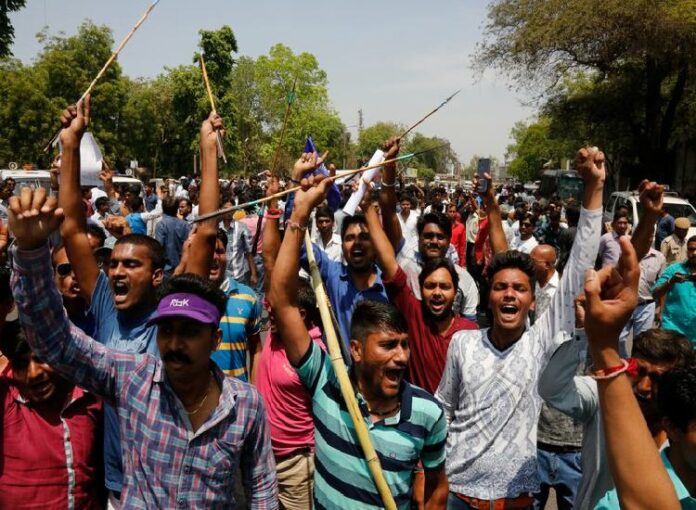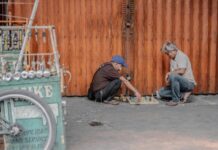Political observers said that BJP is attempting to consolidate the votes of Other Backward Class (OBC) communities ahead of the 2023 Assembly elections in Telangana.
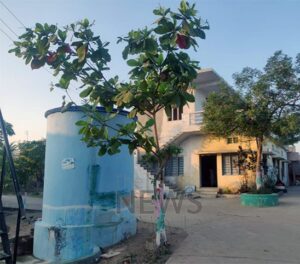 In mid-January, a group of Dalit youngsters in Almaspur of Rajanna Siricilla district in Telangana confronted around 30 local BJP and Rashtriya Swayamsevak Sangh (RSS) functionaries, who had come to their colony to raise funds for the Ram Mandir in Ayodhya, Uttar Pradesh. The youngsters questioned the need for the drive especially when Dalits continue to be discriminated against in the village.
In mid-January, a group of Dalit youngsters in Almaspur of Rajanna Siricilla district in Telangana confronted around 30 local BJP and Rashtriya Swayamsevak Sangh (RSS) functionaries, who had come to their colony to raise funds for the Ram Mandir in Ayodhya, Uttar Pradesh. The youngsters questioned the need for the drive especially when Dalits continue to be discriminated against in the village.
A day later, one of them, who was barely 18 years old, posted a WhatsApp status questioning the need for the fundraising drive to build a temple. He shared a poster which satirically questioned the need for donations when Chief Minister K Chandrasekhar Rao (KCR) built a Lakshmi Narasimha Swamy temple with Rs 1500 crore at Yadadri, without taking a single penny from the people. This triggered another confrontation.
Residents say that around 30 men on bikes came to the Dalit colony late in the night chanting slogans of ‘Jai Shri Ram’. They demanded that the Dalit youth come out of his house and provide an explanation about his WhatsApp status.
 According to the Dalit residents, the men, a majority of whom are Yadavs and from the Backward Class (BC) community, tried to create a ruckus over the issue. However, elders in the Dalit colony managed to defuse the situation, pacifying the men pointing out that it was late in the night, and dispersed the crowd.
According to the Dalit residents, the men, a majority of whom are Yadavs and from the Backward Class (BC) community, tried to create a ruckus over the issue. However, elders in the Dalit colony managed to defuse the situation, pacifying the men pointing out that it was late in the night, and dispersed the crowd.
The confrontation in Almaspur, however, didn’t go down well with local BJP youth cadre. And on January 21, the issue came to a head when the Gram Panchayat Sarpanch and other locals began discussing a dispute over a piece of six guntas of land. The land had been sold to Dalits from a landlord around four decades ago but remained a source of dispute. The Dalit community alleged that in the backdrop of the row, a local BJP leader had claimed rights over the land, obstructing their bid to build a community hall.
“When the land issue was being discussed, the Dalit youth was questioned by BJP functionaries over his WhatsApp status”, said local Rythu Samanvaya Samiti (Farmers’ Coordination Committee) president and TRS leader Radharapu Shankar. He recounted that some people began recording the incident on a phone, despite objections.
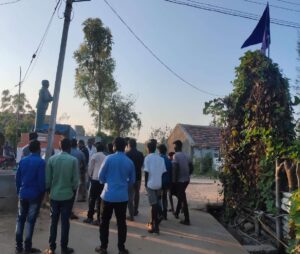 “In that moment, a ruckus was created by youth who are active in BJP and some others, who then attacked other Dalit youth with sticks and stones. The shirts of the Dalit youth were also torn,” Radharapu said. The videos of the clash circulated on social media, drawing criticism from Dalit organisations and TRS leaders, who demanded arrest of the accused.
“In that moment, a ruckus was created by youth who are active in BJP and some others, who then attacked other Dalit youth with sticks and stones. The shirts of the Dalit youth were also torn,” Radharapu said. The videos of the clash circulated on social media, drawing criticism from Dalit organisations and TRS leaders, who demanded arrest of the accused.
Police later booked over a dozen men including the BJP village committee president, and a yuva morcha member, who is a minor, for attacking people from the Scheduled Caste community.
Growing Attacks
Attacks on Dalits in Telangana are not new. What’s new, however, is ‘perpetrators’ coming from the Backward Class communities who stand just a step above Dalits in the Hindu caste hierarchy. Members of the Dalit community atribute this recent trend of violence to the fact that they have been asserting their rights and standing up for their self-respect. Several observers also viewed the recent caste tensions as the result of BJP’s attempt to consolidate the votes of BC communities ahead of the 2023 Assembly elections in Telangana. The Dalit community said that as a result of their assertion, they are often facing ostracisation and even social boycotts.
 With a population of around 2,000, Almaspur village in Yellareddypet mandal falls under Sircilla Assembly constituency, which is represented by state Minister for IT and Industries KT Rama Rao, who is also the son of CM K Chandrasekhar Rao. The village demography suggests that it consists of over 65% OBC (Other Backward Classes) or BCs.
With a population of around 2,000, Almaspur village in Yellareddypet mandal falls under Sircilla Assembly constituency, which is represented by state Minister for IT and Industries KT Rama Rao, who is also the son of CM K Chandrasekhar Rao. The village demography suggests that it consists of over 65% OBC (Other Backward Classes) or BCs.
During #KhabarLive interaction with the Dalit community, they said that their assertion in terms of education and ability to stand up had not gone down well with many. Out of the 10 wards in the Gram Panchayat at least three were won by Scheduled Castes (SC), with the backing of TRS party in the previous local body polls.
“The only reason people are coming out against us is because most of us are studying and know about Dr BR Ambedkar, who gave us the right to study. They have a problem with us speaking up,” said Pramod, a ward member from the community, when asked about what was causing the rift.
According to him, a group allegedly backed by RSS tried to attack them earlier on Dasara eve over a WhatsApp status, that reportedly opposed the burning of an effigy of Ravana claiming him as the Dalits’ god. Another youth, Anil, said, “Since some of the Dalits are going to church, they were threatening to vacate us from the village, though it is an individual’s interest to go or not to go.”
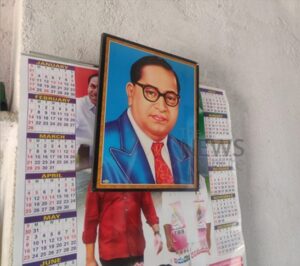 Kiran, who put up the recent status that led to the attack, said, “The same poster was put up by someone else from a dominant caste but they were not publicly questioned about it. It is just because I’m a Dalit.”
Kiran, who put up the recent status that led to the attack, said, “The same poster was put up by someone else from a dominant caste but they were not publicly questioned about it. It is just because I’m a Dalit.”
When #KhabarLive caught up with Kiran, the young man was sitting under a tent where the Dalit community is planning to construct a community hall with the help of the government. Citing recent attacks on the Dalit community, Kiran said that it was ironical to ask for donations to the Ram temple, when they were not treated equally even in the village.
Citing instances of caste discrimination in the village, Anil, who is a graduate, said, “Every year they conduct a jatara (procession) at the nearby Mallanna temple. When any Dalit boards an autorickshaw that is enaged to ferry devotees, no one will get into it. That auto will go empty.”
Radharapu and other local TRS leaders who didn’t wish to be named, allege that most of the time, it is young BJP members in their 20s or people with an inclination towards its ideology, who are ‘radicalised’ via social media and pick up fights on village WhatsApp groups.
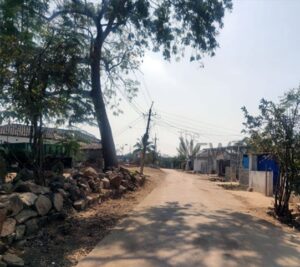 Radharapu used to stay active in the village WhatsApp group thinking it might be useful for communication, as his wife Pushpa, is Sarpanch of the village. However, he quit the group as it became a bedrock for “religious messages” and “fake news” and name calling TRS leaders, he said. “I have come out of the group. All that they were doing is posting religious posts, fake news and sometimes hateful content,” Radharapu said.
Radharapu used to stay active in the village WhatsApp group thinking it might be useful for communication, as his wife Pushpa, is Sarpanch of the village. However, he quit the group as it became a bedrock for “religious messages” and “fake news” and name calling TRS leaders, he said. “I have come out of the group. All that they were doing is posting religious posts, fake news and sometimes hateful content,” Radharapu said.
Political observers said that the radicalisation of the BC community has led to similar incidents across the district and the state.
Fight Over Statues
In October last year, in Ramoji Peta of neighbouring Ellanthakunta mandal, 30 Dalit families were attacked by the members of Mudhiraj community who are categorised as Backward Classes (BCs). During #KhabarLive visit, Dalits said that it was their idea for several years to set up a Dr BR Ambedkar statue in the village, which triggered the tension.
E Mallavva, a Dalit woman in her late 50s said, “They didn’t want Ambedkar statue in the middle of the village.”
The friction continued for months as the Dalit families wanted to set up an Ambedker statue, while the Mudhiraj community, who were allegedly backed by the mandal BJP president, were wanting to set up a Chatrapathi Shivaji statue, who is projected as a Hindu nationalist.
Deputy Sarpanch Bejjanki Srinivas, who is also Dalit, alleged that in October last year on the day of Dasara, the Mudhiraj community deliberately picked up a fight to attack them. He said, “We have not objected when they installed a music system a day before that, but on the eve of the festival, when we installed a music system, the Sarpanch and others complained of disturbance and noise. Even as we were talking, they turned off the power and started attacking us with sticks, rods and stones.”
The families alleged that the attackers used casteist slurs as the Dalit community set up a sound system and wanted to erect the Ambedkar statue.
 The Deputy Sarpanch also alleged that BJP leader Tirupati Reddy had instigated the Mudhiraj community against the Dalit community’s plan to set up an Ambedkar statue. He alleged, “Most of them are being organised by BJP leaders under the banner of Bajrang Dal. We got to know that they have held meetings at a temple earlier near the village.”
The Deputy Sarpanch also alleged that BJP leader Tirupati Reddy had instigated the Mudhiraj community against the Dalit community’s plan to set up an Ambedkar statue. He alleged, “Most of them are being organised by BJP leaders under the banner of Bajrang Dal. We got to know that they have held meetings at a temple earlier near the village.”
Fact-finding visits by human rights groups have said that several persons including women were injured. The activists who visited the village following the incident also alleged BJP leaders’ role in instigating the Mudhiraj community against Dalits.
The repercussions of the attack, however, are still being felt in the village, even as those accused in the crime have since been released on bail.
Balaiah, a 45-year-old Dalit man who was injured in the attack, died recently. His family’s only source of livelihood, a buffalo which Balaiah bought with a loan of Rs 80,000, was attacked and has since stopped giving milk.
When #KhabarLive visited the spot, it was learnt that there was a police picket had been set up months ago between the Dalit colony and Mudhiraj colony, which lies in the main area of the village. The police picket, however, has since been removed.
There has, however, been no dialogue or talks between the two communities after the violent fallout in October.
Almaspur and Ramaoji villages in Telangana aren’t the only ones simmering from caste tensions.
During Dasara celebrations in Sangem Srirampur of Jagtial district, as many as 25 Dalits opposed the burning of a Mahishasura effigy. They opposed it ideologically and also said that there was an Ambedkar statue nearby. Following the incident, Dalit families alleged that they were socially boycotted and diktats were issued against social interactions with them.
In Guvvalegi of Siddipet in Dubbaka Assembly constituency, Dalits were allegedly physically assaulted by members of the Mudhiraj community as they tried to install a Dr BR Ambedkar statue. The incident took place days after BJP’s win in Dubbaka bye-election in November.
A senior police officer declined to comment on the allegations of systematic instigation and ‘radicalisation’ of OBC youths against the Dalits through WhatsApp and other modes. The officer said that a conclusion in that direction requires “some evidence or an investigation.”
Violence With Social Media Posts
In all the incidents reported above, the accused mainly hailed from BC communities. Intelligentsia from the BC community said that they are not being given enough political representation, despite being more than 65% of the population. In fact, several communities such as Mudhiraj are educationally and socially backward compared to BC communities like Munnurukapus, Yadavs and Gouds and there is pent up anger.
Several observers said that in the run-up to the 2023 Assembly elections, the BJP is consolidating the “politically aspiring” BCs in rural areas. Out of four BJP MPs, two are from Munnurukapu caste (BC) and recently, Dr K Laxman was appointed as National OBC Morcha President. Other backward communities too, in the countryside at least, are rallying behind the BJP.
Abhinav Buram, Kula Nirmulana Porata Samithi (KNPS) state General Secretary said that the slurs used by the accused in the Almaspur case shows the infiltration of Hindutva and a grudge on Dalits who are standing up for self-respect. He alleged, “RSS and Hindutva forces are targeting assertive Dalits who are bringing up Ambedkar into every facet. In all these incidents, RSS used some BCs to attack Dalits.”
Observers also pointed to the drawing of OBCs into the Hindutva fold through religious-cultural activities by using their innate inclination towards religion. Recently, OBC leader and Telangana BJP President Bandi Sanjay organised protests after a TRS MLA questioned the need to fundraise for the Ram Mandir. Dalit groups incidentally also protested against the TRS MLA’s remarks against reservation, claiming that the lower castes lack merit.
Sangishetty Srinivas, prominent author and political critic from OBC community, said, “The BJP in Telangana seems to be using the double-edged social dynamic of the OBCs in its favour. On one hand, it is pitching lower BCs against Dalits using the former community’s lack of literacy, education and on the other hand, riding on OBCs who are relatively well off by proposing political power for them.”
Sangishetty warned that the RSS would use BCs to benefit themselves even while making them scapegoats. “If BCs aren’t conscious, they will end up as the losers in the future,” he said.
Manikanta Pallikonda, a political science research scholar and columnist, said that the attacks by OBCs on Dalits is the result of propaganda by the Hindu right wing. He observed, “It is of no doubt that Hindutva or BJP is trying tirelessly to bring BCs to their fold. But the BC communities completely forget that it is the same Hindutva elements who opposed OBC reservation and invoked Ram against the Mandal Commission. And now the same elements once again are invoking Ram to normalise the subordination and political untouchability of BCs.”
The research scholar added that the right wing was further ‘othering’ those who speak out against Hindutva forces. He pointed out that Dalits and many others opposed the Ram Mandir fund collection because many common citizens and oppressed groups are in a distressed state particularly after the COVID-19 pandemic. “Having mere divine structures and an emphasis on robust religious nationalism doesn’t emancipate the masses from the structural inequalities,” he noted. #KhabarLive #hydnews

